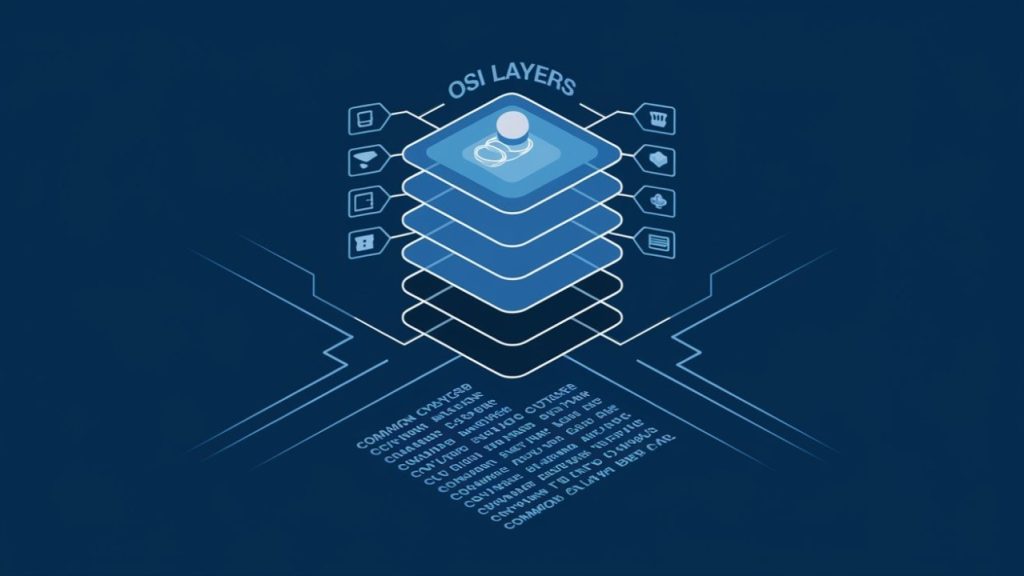Understanding OSI Layers and Common Cyber Attacks
Understanding OSI Layers and Common Cyber Attacks
- Articles
- November 18, 2024

The Open Systems Interconnection (OSI) model is a conceptual framework used to understand network interactions in seven layers. Each layer has specific roles and is vulnerable to distinct types of cyberattacks. In this article, we’ll explore the OSI model and its associated security challenges.
1. Physical Layer: Eavesdropping and Tampering
The physical layer manages raw data transmission over hardware like cables and switches. Attacks on this layer include:
- Eavesdropping/Tapping: Intercepting communication signals.
- Physical Tampering: Disrupting cables or devices to halt connectivity.
- Electromagnetic Interference: Affecting signal quality.
Protection Measures:
- Use fiber optic cables for secure data transmission.
- Ensure physical access controls.
2. Data Link Layer: ARP Spoofing and MAC Flooding
This layer oversees data frame transfer between connected devices. Common attacks include:
- MAC Address Spoofing: Imitating a legitimate MAC address to intercept traffic.
- ARP Spoofing: Manipulating Address Resolution Protocol tables to redirect traffic.
- Switch Flooding: Overloading switches to disrupt data flow.
Protection Measures:
- Implement port security on switches.
- Use dynamic ARP inspection (DAI).
3. Network Layer: IP Spoofing and Route Manipulation
The network layer routes data packets across different networks. Threats include:
- IP Spoofing: Pretending to be another IP to gain unauthorized access.
- Route Table Manipulation: Altering routing paths to intercept data.
- Smurf Attacks: Amplifying network traffic to overwhelm targets.
Protection Measures:
- Deploy firewalls and packet filtering.
- Use IPsec to secure data at the network layer.
4. Transport Layer: SYN Floods and UDP Floods
This layer ensures end-to-end communication and manages error handling. Common attacks include:
- SYN Flood: Overloading servers by sending excessive connection requests.
- UDP Flood: Targeting servers with an overwhelming number of UDP packets.
Protection Measures:
- Configure rate limiting on servers.
- Deploy intrusion detection systems (IDS).
5. Session Layer: Session Hijacking
The session layer handles the creation, maintenance, and termination of communication sessions. Notable attacks include:
- Session Replay: Reusing valid session credentials to access systems.
- Session Fixation: Forcing a user to authenticate with a pre-defined session ID.
- Man-in-the-Middle Attacks: Intercepting and altering communication between devices.
Protection Measures:
- Use secure socket layers (SSL).
- Implement multi-factor authentication (MFA).
6. Presentation Layer: SSL Stripping and Encoding Manipulation
This layer translates data formats and manages encryption. Typical attacks include:
- Character Encoding Attacks: Exploiting poorly validated input formats.
- SSL Stripping: Downgrading secure HTTPS to HTTP to intercept data.
- Data Compression Manipulation: Leveraging vulnerabilities in compression algorithms.
Protection Measures:
- Use TLS/SSL certificates.
- Regularly audit encoding processes.
7. Application Layer: SQL Injection and DDoS
The application layer interfaces directly with user applications like web browsers. Top threats include:
- SQL Injection: Manipulating database queries through user input.
- Cross-Site Scripting (XSS): Injecting malicious scripts into web pages.
- DDoS Attacks: Overwhelming a system with a flood of requests.
Protection Measures:
- Sanitize user inputs and use prepared statements.
- Deploy web application firewalls (WAFs).
Why OSI Layer Security is Crucial
Each OSI layer plays a vital role in network communication, and vulnerabilities in any layer can compromise the entire system. Understanding and mitigating these risks are essential for robust cybersecurity.
Final Tip: Combine network monitoring tools with layered security measures to enhance overall defense. By addressing vulnerabilities at each layer, organizations can create a secure network infrastructure.